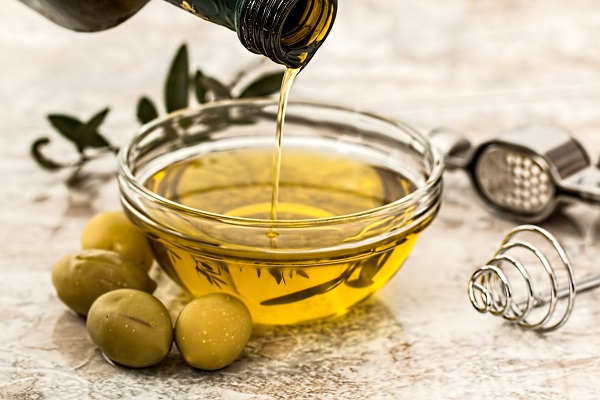Posted: 16th November 2017 | Back to news feed

Dr David Marlin explores the science behind feeding oil to horses and how to choose the best one for your horses needs.
As the temperatures drop, adding some oil into your horses’ diet can be a safe and effective way to help keep condition on older horses and poor doers. However some oil in the diet is beneficial for a number of different reasons. Firstly, oil is concentrated source of energy so it’s very effective as an energy source for horses in hard work such as racehorses, especially for horses that can be overfaced by large feeds. In general a half a scoop of oil would contain the same amount of energy as a full scoop of concentrates.

SKIN & COAT, GASTRIC ULCERS and TYING-UP/PSSM
Oil is also great for skin and coat condition and can help horses with skin problems such as Sweet Itch. Replacing starch with oil is also effective in managing horses with gastric ulcers – contrary to popular belief its removing starch not adding oil that improves gastric health. For probably 25 years or more a standard management for horses prone to tying-up has been to switch to a low starch, high oil diet and this is still one of the most important nutritional management changes for such horses.
RESPIRATORY DISEASE & COLIC
Oil added to the feed also reduces dust so can be used in management of horses with allergic respiratory disease (equine asthma/RAO/COPD/IAD). Finally, last but not least, adding oil is something I use in horses that are prone to recurrent colic and in my experience greatly reduces the severity and frequency of episodes in the majority of horses.
In the last few months I have been getting a lot of enquiries from owners about wheat oil which seems to be heavily marketed. So with so many different oils and brands on the market, how can you decide which oil is the best to feed?
QUICK FAT FACTS
(1) The difference between an oil and a fat is that oils are liquid at room temperatures and fats are solid
(2) Even though the horses natural diet is very low in oils and fats horse can digest moderately high amounts in the diet
(3) The fats usually present in plants are unsaturated fatty acid
(4) Increasing fat/oil in the diet delays gastric emptying
(5) Oil in the diet does not have a direct effect on gastric ulcers. It’s removing starch and replacing it with another energy source such as oil that helps
(6) The main area for fat digestion and absorption is in the small intestine (the section of the gut immediately after the stomach)
(7) If too much oil is added to the diet horses can develop loose droppings due to disturbance of the hindgut bacteria
(8) In ruminants unsaturated fats have a greater effect negative effect on the gut bacteria than saturated fats
(9) The horses’ ability to digest fat/oil is highest (60-95% digested) when added as pure oil, compared with 5-60% in forage and 50-75% in grains
(10) Less heat is produced from the digestion of fat/oil compared with the digestion of forage
(11) Increasing fat/oil in the diet increases the horses use of Vitamin E
(12) Adding fat/oil at around 500ml per day is well tolerated by the majority of horses
(13) Adding oil to the diet can help gastric ulcers but only if used as a replacement energy source for starch. It’s removing starch not adding oil that has the effect. Oil itself has no effect on gastric ulcers – urban myth!
(14) Omega 3 and Omega 6 Fatty Acids – These are present in varying amounts in oils fed to horses. In simple terms, Omega 6 fatty acids in fats or oils promote inflammatory responses whilst Omega 3 fatty acids. It’s considered highly desirable to have at least twice as much Omega 3 as Omega 6
(15) The energy from oil/fat is similar whatever the source (e.g. corn, linseed, soya, etc) – around 3.7 MJ per 100g or 100ml. A 500kg horse in light-medium work may need a total of 100 MJ per day (from the total diet – forage + concentrates + oil)
(16) Fats/oils exposed to air and light degrade which can lead to reduced palatability, loss of vitamins and formation of carcinogenic and pro-inflammatory compounds which in people have been linked to neurological disease, heart disease and cancer.
OILS COMMONLY FED TO HORSES
WHEAT OIL
+ palatable
+ provides small amounts of Vitamin E and K
+ cheap (very cheap as a raw material so should be cheap as a finished product)
- low in Omega 3 (7g/100ml of oil)
- very high in Omega 6 (55g/100ml of oil)
OAT OIL
+ palatable
+ some Vitamin E & K
+ cheap (very cheap as a raw material so should be cheap as a finished product)
- low in Omega 3 (2g/100ml of oil)
- very high in Omega 6 (39g/100ml of oil)
LINSEED OIL/FLAXSEED OIL
+ highly palatable
+ highest in Omega 3 (53g/100ml of oil)
+ low in Omega 6 (13g/100ml of oil)
+ Omega 3:6 ratio of over 4:1
+ provides a small amount of Vitamin E
CORN OIL
+ very cheap
+ reasonably palatable
+ widely available in Supermarkets
+ provides small amounts of Vitamin E and K
- highly processed
- very low in Omega 3 (1g/100ml of oil)
- very high in Omega 6 (54g/100ml of oil)
HEMP OIL
+ moderate amount of Omega 3 (21g/100ml of oil)
+ low in saturated fat
- high in Omega 6 (59g/100ml of oil)
RAPESEED OIL
+ cheap
- Low level of Omega 3 (9g/100ml of oil)
- Moderate amount of Omega 6 (20g/100ml of oil)
COCONUT OIL
+ palatable
+ low Omega 6 (2g/100ml of oil)
+ low in polyunsaturated fat
- very very high in saturated fat
- NO Omega 3
- provides almost no vitamins
RICE BRAN OIL
+ palatable
+ provides small amounts of Vitamin E and K
- low Omega 3 (2g/100ml of oil)
- very high Omega 6 (33g/100ml of oil)
SOYA OIL
+palatable
+provides small amounts of Vitamin E and K
+provides some Omega 3 (7g/100ml of oil)
-very high in Omega 6 (50g/100ml of oil)
SUNFLOWER OIL
+ provides small amounts of Vitamin E and K
+ cheap
- NO Omega 3
- very high Omega 6 (66g/100ml of oil)
OLIVE OIL
+ provides small amounts of Vitamin E and K
- low in Omega 3 (1g/100ml of oil)
- high in Omega 6 (10g/100ml of oil)
Buglossoides Arvensis SEED OIL (AHIFLOWER OIL)
+ high Omega 3
+ low Omega 6
+ good conversion to EPA and DHA
- long term feeding safety in horses and people still to be determined
- very expensive (e.g. around 7 times more expensive than linseed oil)
- vitamin E content unknown?
DECIDING WHICH OIL TO FEED
I particularly avoid using WHEAT oil and OAT oil (no matter that some products claim special processing – it’s still wheat oil or oat oil), corn oil, hemp oil, rice bran oil, soya oil, olive oil and sunflower oil for horses with or prone to gastric ulcers, loose droppings, colic, respiratory or skin disease. Coconut oil is borderline acceptable as an energy source and is low in Omega 6 but provides no Omega 3’s and is relatively expensive. Ahiflower oil could be a good option but is currently very very expensive and as it has only just appeared we have no indication of the long term effects of feeding it to horses. Linseed oil is still the best oil for horses based on profile, palatability, availability and price.
DECIDING WHICH OIL TO BUY
Here are some general guidelines to help you decide which oil product to purchase.
1) Particularly avoid wheat oil, oat oil, corn oil, soya oil, rice bran oil and sunflower oil – ALL HIGH in Omega 6 and LOW in Omega 3
2) Don’t buy any oils that are in clear or light coloured plastic containers. Oil is oxidised by even very low levels of UV light
3) Avoid products with a large airspace above the oil – the more air in the container the greater the oxidation
4) Oils with antioxidants added (synthetic or natural e.g. rosemary) improve storage and reduce oxidation
5) Cold-pressed oils will have lower levels of oxidation than highly processed oils
6) Adding oil to the diet requires more Vitamin E (at least 1IU per ml). So if you are feeding 300ml per day your horse needs at least 300IU of Vitamin E more in the diet. Alternatively, you can buy some oil products with the Vitamin E already added for you
The Equestrian Index newsfeed is compiled from articles submitted by advertising members and expresses the opinions of those members. Watsons Directories Ltd shall not be held liable for any inaccuracies or mis-statements therein.